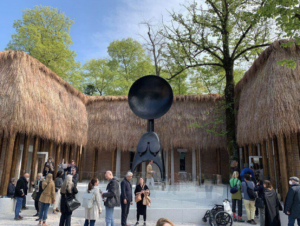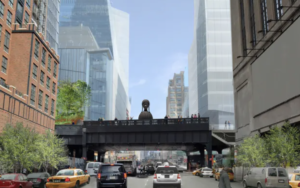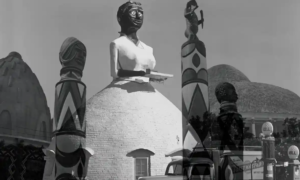Contemporary art case: Simone Leigh, who "decodes the construction of black female subjectivity".
She was born in Chicago in 1967 and is of Jamaican descent. Her artwork takes the form of sculpture, video, and installations and addresses issues such as African history, black women, and racial policy. Through interviews and fieldwork, the artist feels social issues personally. She also calls her work “autoethnography“.
Rashida Bumbray, who worked with her, once said in an interview with the New York Times that “what Leigh has done is to establish the aesthetics of black women as beautiful. awareness and spread the change widely.”
- Pottery sculpture is the presentation form of her representative works. Stylistically, she strives to combine traditional African pottery with modern styles. The diversity of these two aspects was evaluated by the curator Glenn Adamson as “rethinking the art of pottery” and “making people rethink the existing art categories”.
𝐁𝐫𝐢𝐧𝐠 𝐛𝐥𝐚𝐜𝐤 𝐰𝐨𝐦𝐞𝐧’𝐬 𝐚𝐞𝐬𝐭𝐡𝐞𝐭𝐢𝐜𝐬 𝐢𝐧𝐭𝐨 𝐭𝐡𝐞 𝐩𝐮𝐛𝐥𝐢𝐜 𝐞𝐲𝐞.
Her work was exhibited at the Luhiring Augustine Gallery in New York, and her “Face Jug” series of vases and jugs fashioned in the shape of a woman’s head was inspired by traditional African jugs with human faces, which are often thought of as The fusion of human body and tool. Lauren Wittels, director of the exhibition hall, believes that Leigh’s sculptures are like “another form of human beings” and that “they have a mournful quality”.

The work “Brick House” is a bust of woman-thin braids from the forehead to the shoulders, and the torso is full of skirts, which is also similar to a domed house. The image was inspired by the old funk band The Commodores’ “Brick House” that Simone Leigh heard on the radio when she was a child: “She’s a brick house, she’s strong…she’s shaped like the Amazon”. she heard a new image of black women in it: beautiful and powerful, not vulnerable. In 2019, it was placed in the High Line Park on the Manhattan Viaduct in New York, becoming a landscape high in the city. The landscape around the sculpture is very “masculine”, as it is full of skyscrapers and cranes. In this setting, there is a prominent figure of a black woman on high who is looked up to as a hero.

(“Brick House” vista. Image via James Corner Field Operations and Diller Scofidio + Renfro, via The City of New York)
𝐓𝐡𝐞 𝐣𝐞𝐟𝐟𝐞𝐫𝐬𝐨𝐧𝐢𝐚𝐧 𝐚𝐫𝐜𝐡𝐢𝐭𝐞𝐜𝐭𝐮𝐫𝐞 𝐰𝐚𝐬 𝐚𝐥𝐬𝐨 𝐜𝐨𝐦𝐩𝐥𝐞𝐭𝐞𝐥𝐲 𝐫𝐞𝐦𝐨𝐝𝐞𝐥𝐞𝐝 𝐛𝐲 𝐒𝐢𝐦𝐨𝐧𝐞 𝐋𝐞𝐢𝐠𝐡.
What was once Neo-Palladian architecture now takes on an African touch. Thatched roofs wrap the rigorously ordered façade, while classical columns are made of wooden poles. The intervention embodies “African palaces”, a concept that reminds viewers of the 1931 Exposition Colonia in Paris, which invited countries to display their “conquered” territories and replicated local architecture, often exhibiting “natives”. “
𝐒𝐡𝐞 𝐜𝐨𝐧𝐭𝐢𝐧𝐮𝐞𝐬 𝐭𝐨 𝐟𝐨𝐜𝐮𝐬 𝐨𝐧 𝐛𝐥𝐚𝐜𝐤 𝐰𝐨𝐦𝐞𝐧’𝐬 𝐡𝐞𝐚𝐥𝐭𝐡 𝐢𝐬𝐬𝐮𝐞𝐬 𝐚𝐧𝐝 𝐫𝐢𝐠𝐡𝐭𝐬 𝐢𝐧 𝐭𝐡𝐞 𝐦𝐞𝐝𝐢𝐜𝐚𝐥 𝐟𝐢𝐞𝐥𝐝.
There are more explicit ways in which Simone Leigh explores the identity and rights of black women. https://www.nbcnews.com/health/health-news/blood-clots-killed-woman-who-died-er-floor-flna1c9452413A Jamaican immigrant collapsed to death after a blood clot traveled from her thigh to her lungs after waiting 24 hours in the waiting room of a Brooklyn hospital; surrounding medical staff, unaware, came to check her pulse 30 minutes after she fell to the ground. Simone Leigh believes that from this incident, it can be seen that “people have no empathy for the pain of black women” and “the greatest threat to the health of black women in compliance.”
The exhibition “Waiting Room” https://www.newmuseum.org/exhibitions/view/simone-leigh-the-waiting-roompresents some public or privatecare methods that are different from traditional medicine, such as herbalism, exercise studios, etc. What she wants to express is that when black women feel hopeless about the expensive medical system controlled by insurance and pharmaceutical companies, they use the methods in the exhibition as self-insurance and adjustment. Simone Leigh herself founded a similar organization “free people’s health clinic” in Brooklyn, which provides routine medical services to black women, as well as classes in dance and herbal medicine.

〈The Artist as Ethnographer》 A critique of the artistic use of ethnographic methods
In his article “The Artist as Ethnography”, Hal Foster mentions many artists who have adopted an anthropological/ethnographic approach and talks about the reasons for the ethnographic turn in contemporary art. Forster keenly grasps the innovative changes brought about by the combination of anthropology and anthropology in the context of contemporary art he observes, but he also expresses great doubts about this turning point. In Foster’s view, the turn, while using a new approach, still contained old presuppositions.
Foster is skeptical of this obsession with the potential for change to remain forever outside of oneself. At the same time, as a post-structuralist, Foster believes that the most problematic presupposition here is the superiority of the “other” (minority groups, the proletariat) over the artist himself (the white bourgeoisie), who It is considered to be truthful and self-evident, while the image of the “other” is consciously or unintentionally ignored in terms of ideological construction. In fact, Foster’s criticism of the “ethnographic turn” revolves around the “alternity” to a considerable extent—the false and unreliable pure and solidified “alternity” is the basic starting point of his discussion.
The issues discussed by Foster have their own specific context, and most of what he focuses on is the creation around the issue of “identity politics” in such western art. A core starting point of “identity politics” is to distinguish “self” from “other”.
Foster is skeptical of this obsession with the potential for change to remain forever outside of oneself. At the same time, as a post-structuralist, Foster believes that the most problematic presupposition here is the superiority of the “other” (minority groups, the proletariat) over the artist himself (the white bourgeoisie), who It is considered to be truthful and self-evident, while the image of the “other” is consciously or unintentionally ignored in terms of ideological construction. In fact, Foster’s criticism of the “ethnographic turn” revolves around the “alternity” to a considerable extent—the false and unreliable pure and solidified “alternity” is the basic starting point of his discussion.
The issues discussed by Foster have their own specific context, and most of what he focuses on is the creation around the issue of “identity politics” in such western art. A core starting point of “identity politics” is to distinguish “self” from “other”.
https://www.novembermag.com/content/hal-foster
➡️ 𝐈 𝐚𝐠𝐫𝐞𝐞
At the end of the article “Artist as Ethnographer”, he reminded with reservations: the application of ethnography in the field of contemporary art often lacks a long-term and in-depth interactive relationship with the participating sites (fields, communities). The principle of participatory observation that ethnography itself emphasizes is often not fully tested, let alone strictly criticized. Those artists who claim to be ethnographic are probably just playing a role-playing “ethnographic self-fashioning”, and their actual participation in the field may be of limited help.
𝐃𝐨 𝐲𝐨𝐮 𝐭𝐡𝐢𝐧𝐤 𝐭𝐡𝐢𝐬 𝐩𝐨𝐬𝐢𝐭𝐢𝐨𝐧 𝐢𝐬 𝐬𝐭𝐢𝐥𝐥 𝐫𝐞𝐥𝐞𝐯𝐚𝐧𝐭 𝐭𝐨𝐝𝐚𝐲 (𝐚𝐥𝐦𝐨𝐬𝐭 𝟑𝟎 𝐲𝐞𝐚𝐫𝐬)❓
Foster’s critique still has much to learn from contemporary Chinese art practice. He put forward a concept—“primitivist fantasy”, which refers to the artist’s shaping of the ideals of ethnic groups outside civilization and in foreign lands into some kind of image that can be pinned on his own political vision, and then demonstrate this through artistic creation. an image. It may be a reference to the “nostalgic fantasy” of some cases in the practice of “art township construction” in the Chinese context. Foster emphasizes the importance of using “imbrication” diagrams to understand the world picture-modern and Pre-modernity, civilization and barbarism are all intertwined and mutually contained. And the problems and solutions they carry are often superimposed on each other, so his position is still meaningful today.

